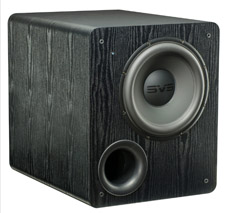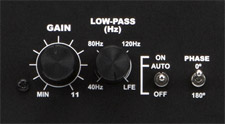It’s the time of year for saving money!
Audiophiles and subwoofers seldom get along. That’s because they don’t understand each other. Yep, not only do most audiophiles not understand subwoofers very well, subwoofers generally aren’t built with the needs of audiophiles in mind.
 It’s a sad situation. Most audiophiles don’t use subs, so they’re missing out on great bass. Obviously, if you’re using stand-mounted speakers without a sub, you’re not getting deep bass. But even if you’re using a big pair of tower speakers, you’re probably not getting good bass. Why? Because you have to position your tower speakers where they’ll deliver the best stereo imaging — which is not where they’ll deliver the smoothest bass response. Measure the frequency response in your listening chair and you’ll see how uneven your bass is.
It’s a sad situation. Most audiophiles don’t use subs, so they’re missing out on great bass. Obviously, if you’re using stand-mounted speakers without a sub, you’re not getting deep bass. But even if you’re using a big pair of tower speakers, you’re probably not getting good bass. Why? Because you have to position your tower speakers where they’ll deliver the best stereo imaging — which is not where they’ll deliver the smoothest bass response. Measure the frequency response in your listening chair and you’ll see how uneven your bass is.
But it’s not the audiophiles’ fault. Home theater enthusiasts have it easy because every A/V receiver or surround processor made since about 1996 has a built-in subwoofer crossover that filters the bass out of the main speakers and the mids and treble out of the sub. In two-channel, almost no preamps or integrated amps have built-in subwoofer crossovers. (The Parasound Halo Integrated 2.1 is the only one I can think of off the top of my head.) The only audiophile-grade standalone subwoofer crossovers I can think of are the JL Audio CR-1. and the Thiel PX05.
(Since this first went to press I’ve gotten some e-mails pointing out a few other two-channel products with built-in sub crossovers: the Classé CP-800 preamp, the Mark Levinson No585 integrated amp, the NAD M12 digital preamp, the Outlaw RR2150 stereo receiver and the Parasound P-5 preamp. And I’m sure there are others. But it’s not a common feature in two-channel gear.)
It’s still quite possible to blend a subwoofer smoothly into a two-channel system by running the main speakers full-range and using the crossover built into the sub to filter the mids and highs out of the sub. But you have to do three things to get it to sound good:
1) Position the sub correctly.
2) Get the crossover frequency right.
3) Choose the right sub in the first place.
I’ve seen many audiophiles position a single sub right against the front wall in their listening room, equidistant from the left and right speakers. I’ve seen others use two subs and put the subs next to the left and right speakers. I assume they do this in the hope that the sub will blend better with the main speakers, but actually, this kind of positioning will probably make the blend worse, because it’s likely to cause big peaks and dips in the bass response. The subwoofer needs to be positioned where it’ll deliver the smoothest bass response. Only then can it be smoothly blended with the mains.
If you have one subwoofer, do the “subwoofer crawl”: Put your sub in your listening chair (yep, in the chair), then play a tune with a melodic bass line and crawl around on the floor along the walls to find the spot where the bass notes sound the most even. Place the sub there.
If you have two subs, put one in each front corner of the room, behind and to the outsides of the main speakers.
 Now find out what the rated bass response of your speaker is (the -3 dB response, not the -10 dB response). If the manufacturer just gives one number, use that. Set the subwoofer’s crossover to the same frequency. Now sit in your listening chair and listen to that melodic bass line again. If the notes sound pretty even, you nailed it. If you hear a dip in the bass response on certain notes, try raising the crossover frequency on the sub by 10 Hz or so. If some of the notes sound bloated, lower the crossover frequency by 10 Hz. Keep playing with it until you get it right or your patience runs out.
Now find out what the rated bass response of your speaker is (the -3 dB response, not the -10 dB response). If the manufacturer just gives one number, use that. Set the subwoofer’s crossover to the same frequency. Now sit in your listening chair and listen to that melodic bass line again. If the notes sound pretty even, you nailed it. If you hear a dip in the bass response on certain notes, try raising the crossover frequency on the sub by 10 Hz or so. If some of the notes sound bloated, lower the crossover frequency by 10 Hz. Keep playing with it until you get it right or your patience runs out.
By the way, this method works whether you connect an extra set of speaker cables to the subwoofer’s speaker-level inputs, or use a line-level connection to the sub from your preamp or integrated amp. Some subs have high-pass-filtered speaker-level outputs you can run to your main speakers. You can try using these, but the effects are unpredictable because they just use a single capacitor in series with the speaker to do the filtering, and its effects will vary depending on the speakers you’re using.
Any well-made subwoofer should sound pretty good in your system if you work to get the blend right. But if you choose carefully, you can get exactly the bass that appeals to your taste. Like it tight’n’punchy? Consider a sealed-box sub. Like more deep bass power? Get a ported sub. Like listening to the super-deep bass of organ recordings and electronic music? Get a bigger sub. I’m generalizing here, but these are pretty good guidelines to start with.
The only subs I’d caution against using in audiophile systems are subs with passive radiators. It’s quite possible to build a passive radiator sub with true audiophile sound quality, but most of them — like the tiny but powerful subs Sunfire is famous for — are built primarily with small size in mind. They’re good for home theater or where visual aesthetics is a big concern, but I recommend a conventional sealed or ported design if you want the best sound quality.





